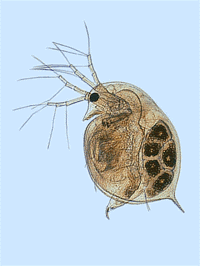Daphnia are one of the best known live foods. They are found in nearly every country in not too clean ponds, though it is not certain that every pond will contain daphnia. The most likely ponds
are those on farms into which a certain quantity of manure finds its way. Whenever you find a daphnia-producing pond, I advise you to guard your secret carefully, lest the news gets around and also the pond is denuded.
How can you tell whether or not there are daphnia present?
A cloud of daphnia seen in a pond looks like a million bugs all crawling, but getting nowhere. The colour of these small crustaceans varies from grey, green, to red. The red coloured are the most sought after, as they’re believed to be the most nutritious.
Daphnia, like fish, require oxygen, and when an oxygen deficiency exists, they behave in the exact same way as fish-they rise to the surface. So on hot, humid days, you’ll see them just under the water’s surface. As daphnia consume oxygen, a big quantity tipped into the aquarium at one time will trigger discomfort to your fish.
Daphnia might be bought from most aquarium supply shops from the spring until autumn, or cultivated in the exact same way as cyclops. They could be graded to suit little fish, by straining in a big strainer comparable to those utilized for straining baby foods, or an old wire mesh tea strainer.
Dried Daphnia
Daphnia may also be obtained in a dried form. I see no reason why it should not be an outstanding food in this form, but it is rather left to speculation as to how a lot of the goodness is destroyed in the drying procedure. Apart from that, dried daphnia has the benefit of being effortlessly stored, and might be utilized when fresh daphnia is out of season.

